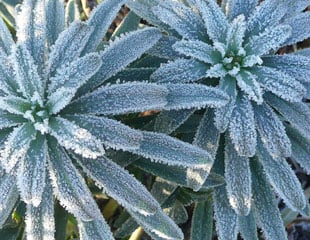
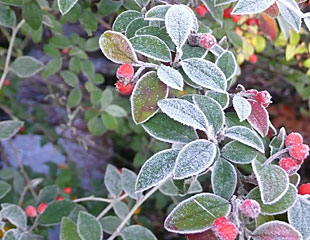
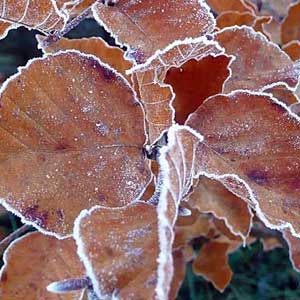
What to do in the garden in December
And even though it is winter, there is colour in the garden and some lovely shrubs including scented shrubs.
Featuring this month:
How to make an eco-friendly Christmas wreath.
Pruning Climbing roses.
Preventing wind rock in roses
2 winter garden videos about overwintering tender plants and safe keeping seeds.
How to protect non hardy plants.
How to prevent water butts from freezing
Why you should thin out forget-me-nots.
Keep off the lawn!
Prevent snow damage to precious shrubs.
Deal with Hellebore black spot.
An easy to make Eco Friendly Christmas Wreath

One of the jobs I absolutely love doing in December is making my own Christmas wreath. If you want to create a beautiful Christmas wreath using natural materials rather than plastic or floral foam, this step-by-step video shows exactly how to do it. Using foliage gathered from the garden — such as holly, fir, ivy, bay and conifer — you’ll learn how to build a compostable and sustainable wreath that costs little to make and looks wonderfully seasonal. Watch the video to see how to prepare your greenery, construct the base, layer the foliage, and add berries, cones or decorations to finish your wreath with a traditional festive look.
Prune climbing roses

From December to February, during a mild spell, is the time to prune a climbing rose.
Start by removing any dead, old and non-productive branches from the base. The images below show the progress of pruning. I inherited this climbing rose, and it had not been pruned for some time. All the growth was at the top. More than one branch from the base looked very old/possibly dead. To ensure that I did not shock the plant, I only removed one old branch from the base, which is illustrated below.
Because no one had pruned the shrub, all the growth was at the top. When I removed one old branch, it created a lot of space, and there's a real lack of new growth from the base. Pruning should encourage new growth from the base.




After removing dead branches, you should prune back any crossing branches and then see what remains.
Of the remaining branches, shorten side shoots by two-thirds and tie in horizontal branches will further protect it against the wind. Feed in the spring. I use Uncle Tom Rose Tonic. I don't have shares or any affiliate links; it's just a very good product. Shop around for price, it varies a lot.
It looks very bare, but that is in part because of the lack of branches from the base, which will grow back this spring,
Prevent Wind Rock in Roses
If you don't have time to prune, you can do a light prune to prevent wind rock. This can be a problem for roses, especially for the taller varieties. Strong winter winds can cause the rose to shift about in the wind, which creates a gap between the stem and the soil. This gap can get bigger as the plant moves about in the wind, which allows water in around the stem, and then to freeze.
It is possible to reduce the plant's vulnerability to "wind rock" by pruning the stems down by around a third. Only prune roses during a mild spell; otherwise, it is possible the frost may damage the growth bud below the cut and cause dieback of the stem.
Winter gardening videos
Two sort winter videos . First, a step-by-step guide how to overwinter tender plants. The second how bes o save and overwinter seeds so they are good for the next year.
Protect Non Hardy Plants
Non-hardy plants require winter protection; follow this link for an explanation of Frosty Hardy.
To ensure winter survival, it is best to bring the plants in under glass, or at least to the shelter of a wall and raise the container so it is off the ground by inserting feet or raising it on bricks. If overwintering outside, it is important to wrap the container with something insulating, bubble wrap, Hessian, or old jumpers, and if it's going to be freezing, cover the plant with a fleece. It is equally important to remove the fleece when the cold spell finishes to ensure the plant gets plenty of air circulation.
Plants covered all winter, or covered up for too much, often get damp, which can cause rot.
Many plants that are not fully hardy will survive in an unheated greenhouse provided it is dry. Winter wet and dampness, which causes botrytis, will damage or kill a plant. It is important to keep borderline hardy plants dry. It is a good tip to knock snow off shrubs when there has been a heavy snowfall.
Prevent water butts from freezing.
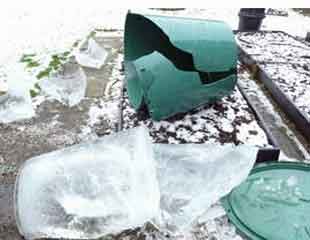
If there is a prolonged spell of low temperatures and freezing weather, it is possible for the water in a water butt to freeze, and this expansion will cause the plastic to fracture as in the image left. I took this image, and it is exactly what happened in my garden during a spell of very bad weather. To avoid costly repairs, drain your water butt if severe weather is predicted.
Thin out Forget-me-nots
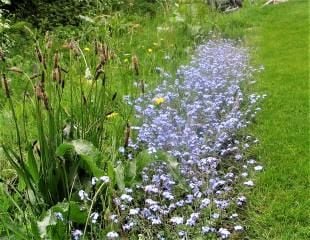
It is good to look forward to Spring, and the Forget-me-nots flowering. They often get a bad press as a zealous self-seeding cottage plant. Bad press or not, forget-me-nots can offer much-welcomed early spring colour and look fantastic with spring bedding and in a natural setting alongside a stream in a semi-wild patch.
For the best spring display of Forget-me-nots, during a mild winter spell, thin out the plants. Forget-me-nots do self-seed a lot, and if they are growing too close together, they are prone to mildew, which can spread to adjoining plants. One year I didn't thin them out, and they overcrowded other plants, and damaged a clump of Hellebores by infecting with mildew. It really is important for the health of the forget-me-nots and the surrounding plants that you thin them out in late autumn or early winter.
Prevent Damage to lawns
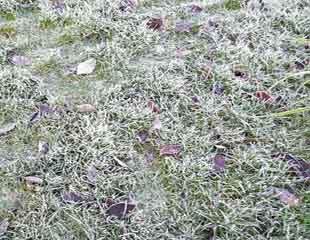
It's true that walking on frost-frozen grass can cause damage. When frozen, the leaves become brittle and will not yield to pressure, which means when trodden on, they snap and break. The image shows the damage from walking on the grass; brown marks where the grass is damaged look unsightly in the spring, and the damage makes that patch more susceptible to disease.
Given how hard it is to create a decent lawn, it's worth resisting walking on it during the very cold weather.
Watch out for snow damage to shrubs
It is a good tip to knock snow off shrubs when there has been a heavy snowfall.
I used to think this advice represented an abundance of caution, making gardening work for work's sake, until we had a bad winter with heavy snow, which badly damaged several shrubs. All shrubs are at risk. What happens is the snow piles into the open centre of the shrub, which forces the branches out until they snap. Also, the snow weighs down the branches, freezes them to the ground, and bends branches over until they snap.
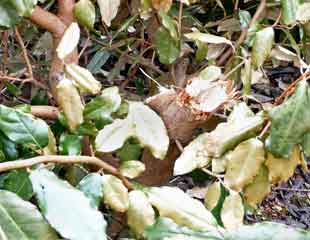
Heavy snow will snap the branches of even mature shrubs. If this happens, all you can do is prune the shrub, but it may never regain its shape if it's severely damaged. A good tip for snowy weather: get out there as soon as you can with a soft broom and brush snow off the tops and loosen branches tied down by snow, which will save the shrub and money if you have to replace it.
I photographed this Elaeagnus in my garden; snow damage devastated it, and I had to prune and cut away many branches. The sheer weight of the snow had bent the branches. Some touched the ground and were held down by the snow, and more snow. Finally, the branches snapped, even mature branches, leaving me with no choice but to cut them off completely; snow pruning a novel experience. Snow is far more destructive than it seems. The short video below shows the effects of snow and how to deal with it to avoid problems.
This video was filmed just after a heavy snowfall and shows just how much damage snow can do. You can almost hear the shrubs sigh of relief as I take a soft broom out and clear away some of the heavy snow, allowing the shrubs and branches to bounce back.
Hellebore black spot
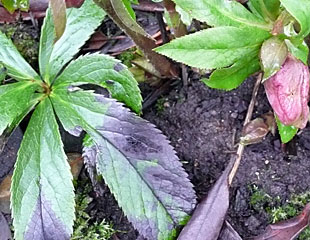
Hellebores can look unsightly with black spot.
The best way to deal with this is to cut off the old leaves from Hellebores (which produce flowers from ground level) to expose the flowers and remove the leaves infected with leaf spot. It is best not to compost the removed leaves because of the black spot infection.
Hellebores are lovely late winter and early spring flowering plants which are easy to grow and will tolerate some shade.
Tips on growing Helleborus and images of many varieties of Hellebore, and some "before and after" images showing how much of the Hellebore leaves you can safely remove.
